How Wide Should A Garden Path Be
Garden path materials – the good, the bad and the beautiful
January 27th, 2019 Posted In: Garden trends & design, Gardening know how
Garden path materials are usually a big investment, so it may be tempting to go for something cheap.
But a beautiful garden path will make such a difference to your garden. And it's likely to be a one-off investment, although some garden path materials need more maintenance than others.

Our garden path was originally gravel inset with concrete pavers. When we had to top up the gravel we used sea shells. Read the full story about a seashell path here.
I have seen a wide range of garden path materials in the gardens I've written about, so I thought I'd pull all my favourite garden path ideas together for you.
You may wish to think about the design of the garden before choosing a garden path. I recommend reading 5 garden design tips (and 2 mistakes to avoid!) and the essentials of garden design.
Note: if you're digging out a garden path yourself, find out where mains water and electricity runs are. You don't want to sever them!
Gravel paths
Gravel is one of the cheapest garden path materials. However it does need a bit of maintenance – blown-in weeds will establish themselves easily in the gravel, even if you have a weed-suppressing membrane.
Is gravel environmentally-friendly? It's more permeable than stone or concrete, so it allows water to drain. But gravel and shingle is mined and transported, so there is an environmental cost.
Gravel will also need renewing every so often – I've found my gravel paths probably need topping up every five years or so. Last year, we renewed our gravel paths by using seashells instead. They're a by-product of the seafood industry, so are environmentally-friendly.

Garden designer and BBC Gardeners' World presenter Mark Lane shows that a gravel path – if properly laid – can also be wheel-friendly. Gravel is one of the least expensive garden path materials.
Laying a gravel path yourself means measuring it out, digging it out and then laying a crushed concrete or aggregate (MOT type 1 base) on it, then tamping that down. You'll then add one or more layers of crushed aggregate until you add the top level of gravel.
There's more about having a gravel path laid in this interview with garden designer and BBC Gardener's World presenter Mark Lane.
Mulch paths
These are easy, inexpensive and environmentally-friendly. They'll need topping up with more mulch every year or so, but you can lay them yourself.
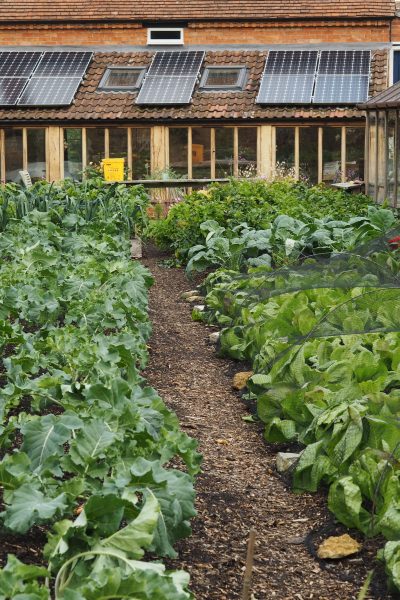
A mulch path is an inexpensive, easy and flexible choice, and it's environmentally friendly. This is in No Dig expert Charles Dowding's vegetable garden.
You don't need to dig out a base for a mulch path. I interviewed a garden owner who had mulch paths everywhere. When a tree blew down over one of the paths, they just re-routed the path around it by buying more bags of mulch.

This is a mulch path in the exotic garden of Steven Edney, head gardener at The Salutation in Kent and his partner, gardener Lou Dowle.
Mown paths
These work in relaxed country-style gardens where there are patches of meadow or orchard.
They're very easy. You just mow where you want the path. Obviously, you have to keep mowing, so they require a little more maintenance than other paths.
But otherwise they're free. However, they will get worn and muddy in very high traffic areas.

A mown path through a mini-meadow in a town garden.
Stone garden paths
Stone is generally a more expensive choice for a garden path.
However, it may never have to be replaced. Our front garden path is made of the original Georgian stone, so although it is a little cracked and weathered, it's still looking good at 200+ years old. I love its patina and the worn dip in the front step where thousands of feet have trodden over the years.
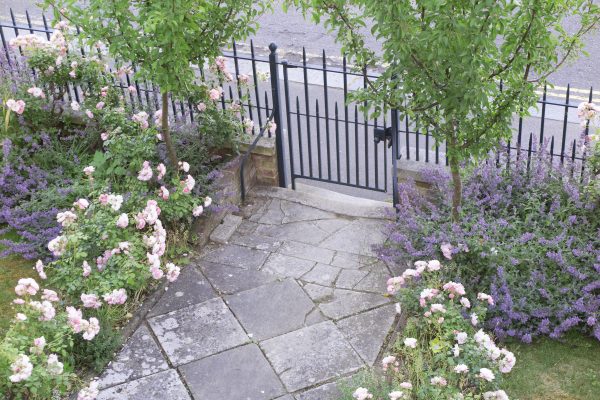
Our stone front path probably dates back to the 18th century. It's a little worn and cracked but a smart new path would look wrong, in my opinion.
Stone is also an easy-care choice. You only have to clean it when it gets moss or algae, which often takes several years to build up. It may look pretty, but it's a slip hazard.
Brick paths
If you use brick for garden paving, it's a good idea to look at your house. If it's built of brick, it will usually look better to echo or match the building.
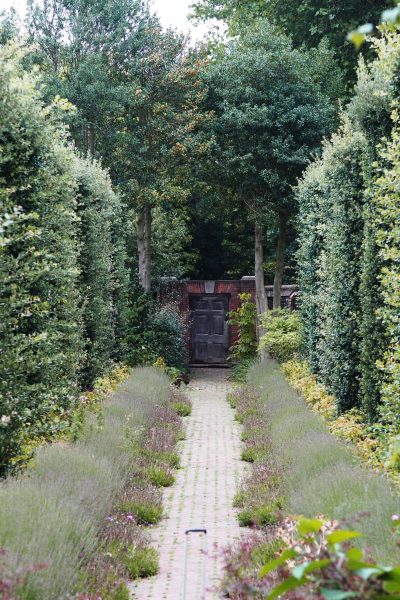
The Salutation in Kent is designed by Edwardian designer Edwin Lutyens. He used the same brick to mark out the garden paths.
When you choose brick or stone garden path materials, think about how you are going to fill the joins. We have pavers on our terrace. Their joins are filled with sand and get weedy.
So when I picked an Indian sandstone for the path, I had the joins filled with cement. After 8 years, the path has more or less weathered in, but until recently it looked very hard compared to the rest of the garden.
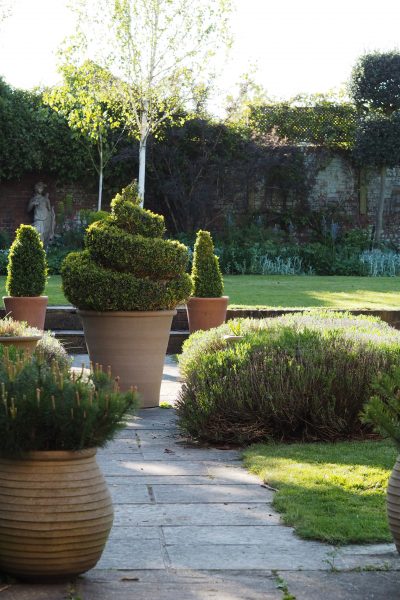
I really wish I hadn't asked for cement in the joins between these pavers. I don't have to weed between them, but it doesn't look as nice to have a continuous hard surface. It has weathered down a bit, though.
Choosing a 'colour' for your garden path materials
Although stone, brick and gravel are largely made of natural materials, they still have a hue or colour. It's really worth thinking about what colours or hues you already have in your garden. Then ask yourself whether you want to echo the themes or contrast with them.
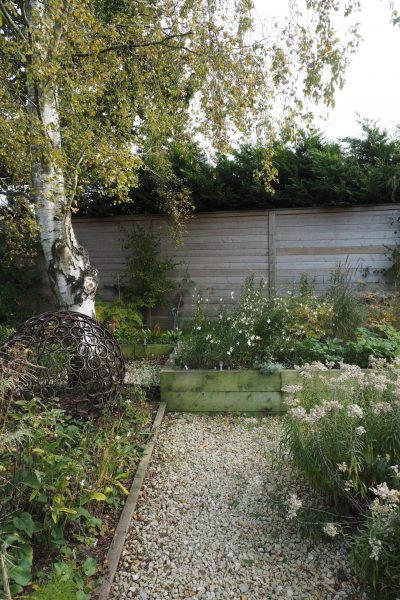
The gravel path at Mark Lane's garden doesn't match the blue grey fence, but the two materials are harmonious.
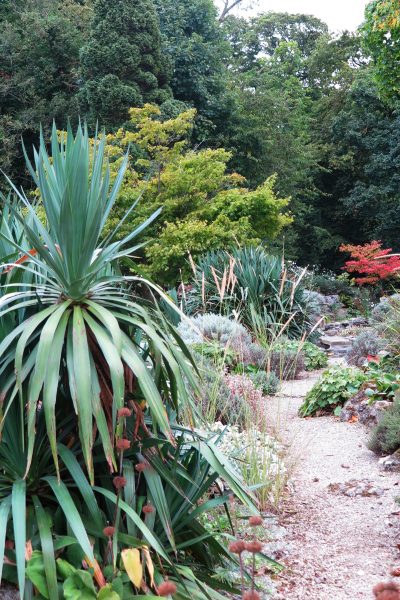
The gravel in the Rock Garden at Doddington Place Gardens harmonises nicely with the rocks.
Echoing – using a yellow brick or creamy stone with a yellow brick house – is usually calmer.
Stepping stones, mixing materials and crazy paving
Crazy paving – or using a mix of materials and shapes – was very fashionable in the mid 20th century. Most mass-market crazy paving doesn't look great, but it can be very creative. And it's an economical choice of materials.
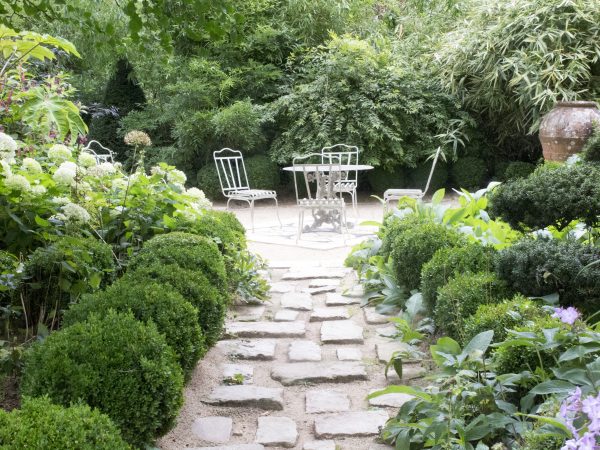
Stepping stones in river sand at the Agapanthe garden in Northern France.
It's environmentally friendly as it can use up off-cuts and scraps that might otherwise be thrown away. And unless the pattern is set in with concrete, it allows rain to run off into the ground between the stones.
Stepping stones are the simplest way of getting across a garden. Many people use off-cuts and set them into the lawn. Even if you need to buy the pavers, you won't need many.
I love garden writer Francine Raymond's simple diamond pattern – she has used just a few square pavers to make a short path.
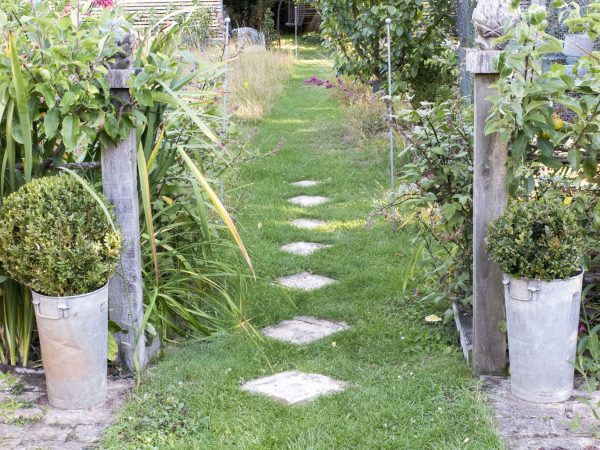
Gardening writer Francine Raymond has inset square pavers to link the more formal part of her garden to the wilder bit at the back.
Unusual garden path materials
A garden in Whitstable has terracotta, tiles and scraps of stone set into an old concrete path. When the owners bought the house, there were worn concrete paths and terrace.
Instead of replacing the paths, they worked patches of concrete free and filled them with patterns made of brick, shells, terracotta and stone.

A creative way to deal with an old concrete path.
Another friend of mine has used old tyres, delivered for free by a local garage. However, when she opened her garden for the Faversham Open Gardens & Garden Market Day (held every year on the last Sunday in June), the pressure of hundreds of feet walking over it made it sag.

This path is made of car tyres. Two rows of tyres mark out the sides, and there are more tyres laid flat under the grassy part.
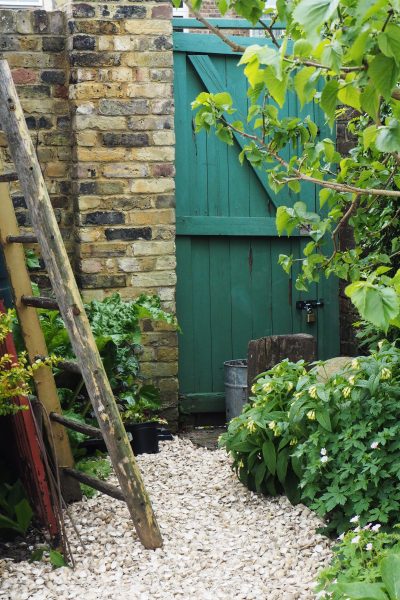
Garden designer Posy Gentles also chose seashells for her garden path.
Can you DIY your garden path?
Some friends of mine have simply wedged bricks or stone into their lawn or beds to create a path. This is fine, but if it's a main way, then they may get dislodged and prove a trip hazard.
The proper way to lay a brick, stone or gravel path is to check where your utilities are. Then measure out your path, either using a garden hose or posts and string.
You dig out the path. It will need to be deep enough to take a membrane, at least one layer of base material and then your topping. If you have a gravel path, you need to make sure the little stones can't spread over the lawn so it needs an edging.
If you have a stone or brick path, you may want to make it easier to mow by making it flush with the lawn. We did this in our parterre and Mr Middlesize mows straight across.
I am not a DIY expert, so I suggest you search on YouTube for tutorials if you want to take laying your own garden path further. Watch a few of them to get a sense of which ones are good or not.
There is some good advice on saving money on garden design here.
Who will lay my garden path?
If you're not going to DIY your garden path, you'll need a landscaping company. Landscaping is the digging, building, excavating and laying side of gardening.
In Britain, you can search BALI (The British Association of Landscape Industries) or the Association of Professional Landscapers for qualified member companies.
Before looking for a landscaping company, read these 12 professional insider tips for landscaping your garden.
And garden paths often involve steps, so read this to find out how garden steps differ from house steps.
This post has more garden paths and garden path advice.
Join us every Sunday morning
To get the Middlesized Garden blog into your inbox every Sunday morning, just follow us by email (see top right of this page).
Pin for reference:

How Wide Should A Garden Path Be
Source: https://www.themiddlesizedgarden.co.uk/garden-path-materials-the-good-the-bad-and-the-beautiful/
Posted by: greenfieldbutivene.blogspot.com

0 Response to "How Wide Should A Garden Path Be"
Post a Comment